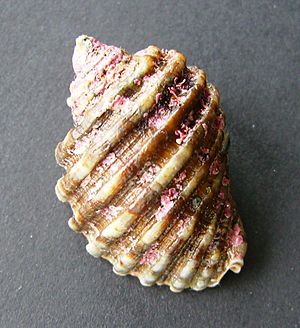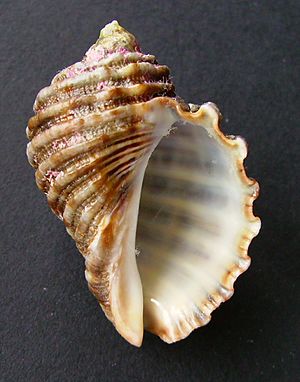Dicathais facts for kids
Quick facts for kids Dicathais |
|
|---|---|
 |
|
| Dorsal view of a shell of Dicathais orbita | |
 |
|
| Apertural view showing the deep crenulations | |
| Scientific classification | |
| Genus: |
Dicathais
|
| Species: |
orbita
|
| Synonyms | |
|
|
The Dicathais is a type of sea snail. It's a mollusc that lives in the ocean and is known for being a predator. There's only one species in this group, called Dicathais orbita. People often call it the white rock shell or cart-rut shell. You can find these snails living along the coasts of Australia and New Zealand.
Contents
What Does the White Rock Shell Look Like?
The white rock shell is a large snail with a very strong shell. It's usually about 6 centimeters (about 2.4 inches) long. Sometimes, it can grow to be twice that size!
Shell Patterns and Shapes
The shell's surface can look very different depending on where the snail lives.
- In eastern Australia, the shell has seven to nine deep ridges. These ridges have grooves of similar width between them. This makes the edge of the shell look wavy or "fluted." You can also see these grooves inside the shell. The central part of the shell, called the columella, is smooth. The inside of the shell is white.
- In western Australia, the shell has a row of bumps, not ridges. The edge of its shell is smooth, not wavy.
- In southern Australia, the ridges are much less clear. The shell's edge is almost smooth.
Why Do Shells Look Different?
For a long time, scientists thought these different shell types meant they were different species of snails. But it turns out, the way the shell looks depends on where the snail lives. Scientists kept snails from New South Wales (which usually have deep ridges) in a calm aquarium for three years. The new parts of their shells grew with shallow ridges at first, and then became smooth. This showed that living conditions change how the shell grows.
Shell Colors
The shell is usually creamy white or gray. It often has a thin yellowish line around the edge. Young snails have thinner shells and are often brown.
Where Do White Rock Shells Live?
These snails are very common on rocks and among seaweed. You can find them in the intertidal zone (the area between high and low tide) and the sublittoral zone (just below the low tide mark). They live along the coasts of Australia (in New South Wales, Queensland, South Australia, Tasmania, Victoria, and Western Australia), New Zealand, the Kermadec islands, and Lord Howe Island.
How Do White Rock Shells Live?
The white rock shell is a predator, meaning it hunts other animals. It can also be a cannibal, eating other white rock shells. And it's a scavenger, eating dead animals.
How They Eat
The snail uses a special tongue-like organ called a radula. It uses its radula to drill a hole into the shell of a barnacle or another mollusc. Once the hole is made, it sucks out the soft parts inside. Some of the animals it eats include other sea snails like Lunella torquata, Cronia avellana, and Pyrene bidentata. It also eats mussels like Septifer bilocularis.
Moving Around
When the tide comes in, the white rock shell goes on "foraging expeditions." This means it travels up the beach to find food. It goes far from the sheltered spots where it hides when the tide is low. This is different from another snail, the mulberry whelk (Morula marginalba), which lives in the same areas. The mulberry whelk stays closer to places where it can hide and find food easily.
How They Reproduce
Male and female white rock shells are separate. The female snail produces eggs. These eggs are wrapped in several layers of membranes, forming an "egg capsule." Several of these capsules are then joined together to make an "egg mass." The snail attaches this egg mass to a rock or other surface.
Inside the capsules, the baby snails develop. They feed on yolk granules, which are like food packets. When they grow into a stage called "veliger larvae," they come out of the capsule. At this point, they become planktonic, meaning they float and drift with the ocean currents. After floating for some time, they settle down on the seabed. Then, they go through a change called metamorphosis and become tiny juvenile snails.

